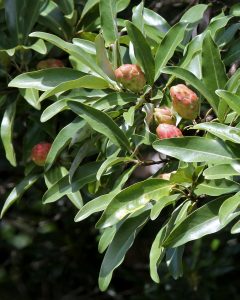Sweetbay Magnolia, Magnolia virginiana

Photo by Scott Zona

Photo by Mary Keim

Photo by Mary Keim
Height: 25-60 feet
Spread: 20-40 feet
LANDSCAPE USE
Excellent for wet, soggy situations, especially along retention ponds, drainage swales, canal banks, and wet roadsides.
FORM
An erect, evergreen tree with a narrow, conical crown and leaves that are silvery below and shiny green above. During breezy weather, trees situated in the open are showy, as they appear to change color from silver to green due to their two-toned leaves.
NATIVE RANGE
Swamps, wetland depressions, stream banks, bay heads, and bogs. Coastal Plain and Piedmont ecosystems, from Massachusetts southward to southern Florida, and west to eastern Texas.
CHARACTERISTICS
Flowers: Fragrant, showy, with creamy white petals surrounding a small, conelike mass of numerous stamens and pistils, 3-6 inches across.
Leaves: Alternate, 3-6 inches long, elliptic outline, dull shiny green above, conspicuously silvery below.
Fruit: Ovoid, knobby, purplish red to purplish conelike structure bearing bright red seeds.
Bark: Gray, smooth, and thin.
CULTURE
Soil: Prefers wet, acid soils, but will adapt to well-drained soils if kept moist.
Exposure: Full sun when growing in wet soils. Also part shade.
Water: Should be kept very moist to wet. Hardiness Zones: 5-10.
Life Span: Moderately long-lived; over 50 years.
BEST FEATURES including WILDLIFE SUPPORT
Wetland habit, showy flowers and leaves, and interesting, showy fruit. Seeds are eaten by wildlife. Woodpeckers really like the seedpods, as do other mmamls. This tree is a larval host for Eastern Tiger Swallowtail and Spicebush butterflies, and the Sweetbay moth. These butterflies and moths are in turn critical food for birds. Valuable for wetland restoration.
COMPANION PLANTS
Inkberry and Gallberry (Ilex glabra and I. coriacea), Staggerbushes, Fetterbushes, and Dog-Hobbles (Lyonia spp. and Leucothoe spp.), Titi (Cyrilla racemiflora), Loblolly Bay (Gordonia lasianthus), Swamp Bay (Persea palustris), Summer Sweet (Clethra alnifolia), Virginia Willow (Itea virginica), Chain Ferns (Woodwardia spp.), Red Maple (Acer rubrum).
DISADVANTAGES
Fallen fruiting cones can be messy.
CULTIVARS
Several cultivars and varieties are known but are not readily available in Florida.
SIMILAR AND RELATED SPECIES
Loblolly Bay (Gordonia lasianthus) is similar to and occurs in the same habitat as Sweetbay. Magnolia (M. grandiflora) and Ashe Magnolia (M. macrophylla var. ashei) arc closely related, as is Tulip Poplar (Liriodendron tulipifera).